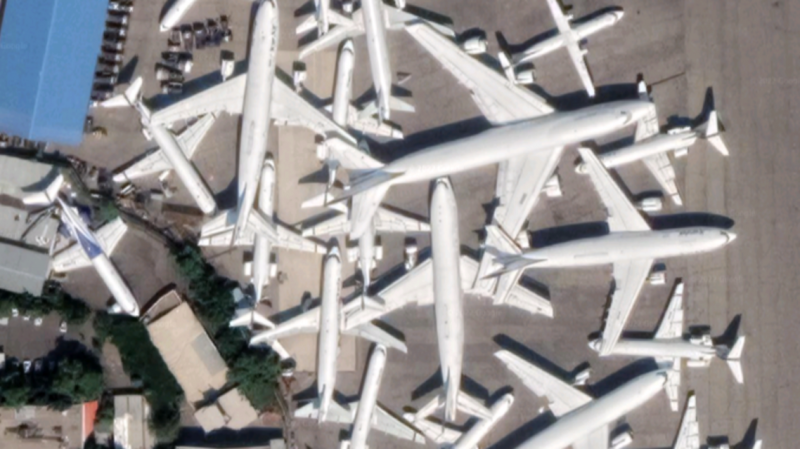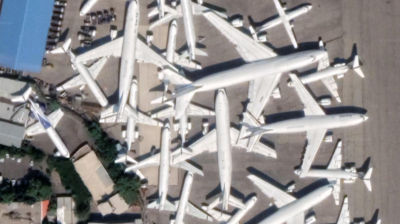It has become nearly impossible for anything to disappear from Earth without being spotted by Google Maps, which recently captured an image of a large number of Iranian commercial aircraft at Mehrabad Airport in the Iranian capital, described as a "graveyard" of planes turned into "sacrificial lambs." Parts from these aircraft are used to operate other Iranian planes suffering from a shortage of spare parts due to the sanctions imposed by the United States on Tehran following the Trump administration's withdrawal from the nuclear deal in 2018.
The publication of images showing a considerable number of stored passenger planes clustered together in a corner of Mehrabad Airport in Tehran has caught the attention and curiosity of many internet users worldwide. The aerial photo of the "aircraft graveyard" was shared by a user named "Ermia Bahrami" last month on Reddit. Shortly after its publication, the photo was featured in the "Amazing Content and Images" section on Reddit, where it garnered more than 10,000 likes.
In the image, about 20 civil aircraft of various sizes can be seen parked in a section of Tehran's Mehrabad International Airport. According to a report by the American weekly magazine "Newsweek," this picture clearly displays the "sad truth" of Iran's dilapidated air fleet, showing many of these airplanes out of service due to technical issues or a lack of spare parts, parked in a hangar at the airport.
Over the past four decades, since the establishment of the "theocratic revolutionary" regime in Iran, Tehran has been unable to purchase new aircraft or spare parts for its air fleet from Western countries due to foreign sanctions, particularly American ones, imposed after the takeover of its embassy in Tehran by students who referred to themselves as "followers of Imam Khomeini." Consequently, Iran became unable to buy spare parts for its aging air fleet and resorted to using parts from older planes to rebuild and repair some of its civil aircraft, as has also been the case for its military fleet.
In this context, Ross Immer, a former pilot for Iranian Airlines in the 1970s, stated to "Newsweek" that all the planes depicted in the published image are passenger aircraft manufactured by "Boeing" and "Airbus," or Russian commercial aircraft, noting that these planes either "lack engines, or some parts have been removed to repair other planes."
It is noteworthy that many of these aircraft are owned by Iraq and were deposited in Iran in January 1991 during the Gulf War, including at least 6 Airbus planes, 5 Boeing aircraft, and 22 Ilyushin planes. According to statistics from the Iraqi Ministry of Foreign Affairs, the number of Iraqi civilian and military aircraft that sought refuge in Iran reached 146, and Tehran has refrained from returning them to Baghdad.
Ross Immer, who has over six decades of experience in the aviation industry, remarked that the aircraft parked at Mehrabad are "useless corpses," and that this spot in the airport is essentially an aircraft graveyard. Most of the Iranian planes were manufactured in the 1970s and early 1980s. According to this retired pilot, parts from these aircraft have been sacrificed in recent years to support other "half-worn" planes in Iran's air fleet.
This seasoned aviator expressed the belief that Iran might manufacture some of the needed parts locally or purchase others from the black market, but to obtain some of the more critical components, it would have to render these dilapidated planes into "scrap," making them entirely unusable and transforming them into "metal waste."
Referring to the largest plane in the image, Immer pointed out that it highlights the very old age of the Iranian air fleet, as this model of "Boeing" entered the market in 1957, with its last flight in American airlines occurring in 1983. Reports indicate that Iranian Airlines used this model of Boeing until 2013.
In an interview with "Newsweek," Iranian Airlines' public relations officer, Hossein Jahani, did not disclose the precise number of operational aircraft in the Iranian fleet but added: "During the negotiations leading to the nuclear deal in 2015, Iran managed to purchase 13 ETI planes for regional flights, but Western countries did not provide Iran with spare parts for these aircraft." He described Western sanctions as "the biggest challenge facing the Iranian aviation industry."
Iranian airlines are closely monitoring the negotiations underway in Vienna to see if the nuclear deal will be revived, enabling them to modernize their air fleet should U.S. sanctions against Iran be lifted.




